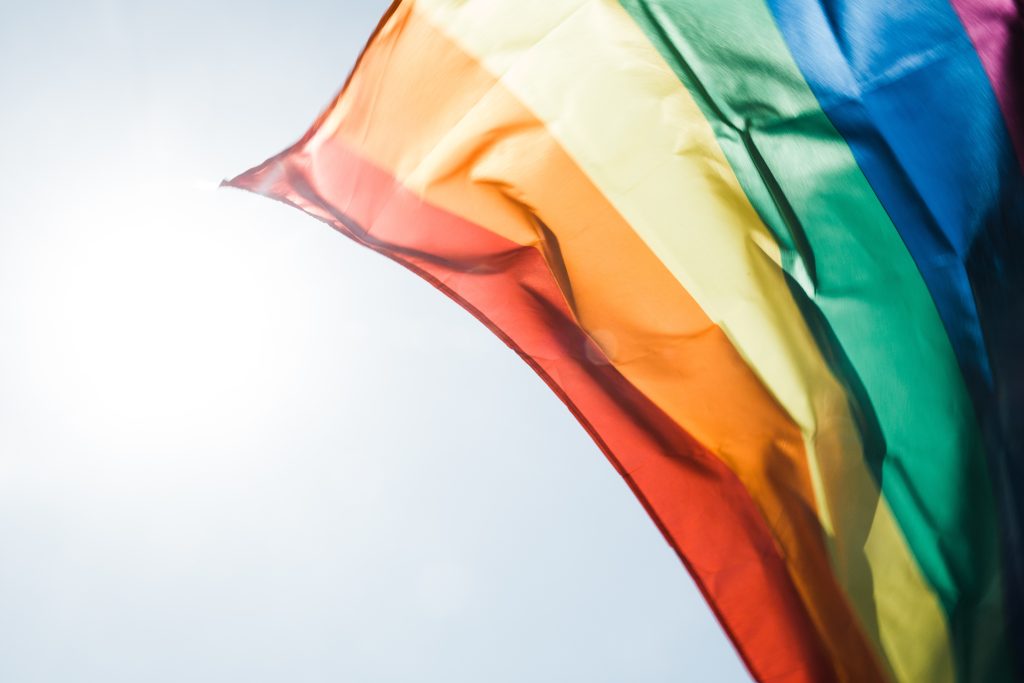
The icon rainbow flag, also known as the Pride flag, has been used as a symbol of pride and solidarity amongst the LGBTQ+ community since 1978. First designed by openly gay activist Gilbert Baker, the flag first flew on 25 June 1978 at San Francisco’s Gay Freedom Day Parade, although it looked a little different to the flag you might recognise from today.
The original pride flag contained eight different coloured stripes which all carried a specific meaning: pink for sex, red for life, orange for healing, yellow for sunlight, green for nature, turquoise for magic, blue for serenity, and purple for spirit. The hot pink was removed in 1978 due to a lack of fabric when attempting to replicate and distribute the flag. The turquoise soon followed and was later removed in 1979 to modify the flag so that it would have an even number of stripes. A lavender stripe was temporarily added at the top of the flag to represent diversity, however, this failed to catch on and the six-striped Pride flag has continued to become the one adopted by the LGBT+ community.
Although the lavender stripe was ultimately rejected, Philadelphia City attempted a new way of adding the importance of diversity into the flag. On 8 June 2017 black and brown stripes were added to the top of the rainbow design to “highlight black and brown LGBTQIA members within the city’s community”. Racism is still horrifically prevalent within the community despite the whole purpose of it being to seek love, support, and acceptance.
Stonewall UK shared research in 2018 that 51% of BAME LGBTQ+ people have faced discrimination from members of their own community. This echoes the staggering number of complaints that the Philadelphia Office of LGBT Affairs faced about racial discrimination within supposed safe spaces, such as gay bars and clubs. The stripes were added as a message of solidarity and a reminder that as a community who fights for equality, we should be ensuring it for all members.
However, this change to the icon flag was not met without backlash and activists criticized the new additions as ‘unnecessary’ and ‘divisive’. Their arguments included that ‘the flag was never about skin colour’, ‘leave the bloody RAINBOW flag alone’, and, of course, ‘where is the white stripe to represent white people?’.
Surely though you would like to think that standing up for the inclusion of your fellow members of the LGBTQ+ community would mean more than the aesthetic of a flag. These new stripes aim to create visibility and move towards equality for BAME community members in the same way the Baker flag did for white members. Why deny someone else what all members of the LGBTQ+ community want?
June 5 2018 saw another redesign of the Pride flag created by Daniel Quasar which built upon the Philadelphia flag to further the desire to bring a focus on inclusion to the community. Quasar added a chevron on the left-hand side of the flag which was white, pink, and blue (the transgender flag) and then black and brown. The new design is reflective of many ideas: ‘the arrow points to the right to show forwards movement while being along the left edge shows that that progress still needs to made’.
Quasar further states that the new design is important as it reminds us that ‘we need to always keep progress moving forward in all aspects of our community’ and to highlight that ‘there is work to be done’ to achieve inclusion. The flag has in fact been named ‘Progress’ to reflect its aims to include all minorities of the LGBTQ+ community.
Whilst it’s clear that adding stripes to the original Pride flag is not nearly enough to combat the discrimination faced by BAME and other minority groups within the community, it is a start in spreading awareness. At the end of the day we are all fighting for the same thing, why spread hate and negativity and get so caught up in the colours of a flag when we could be spreading love and support to people who need it? Let’s keep this community based in kindness and let the flag serve as a much needed reminder to give the acceptance we wish to receive.
To quote artist and social justice activist Micah Bazant: ‘No pride for some of us, without liberation for all of us”.
